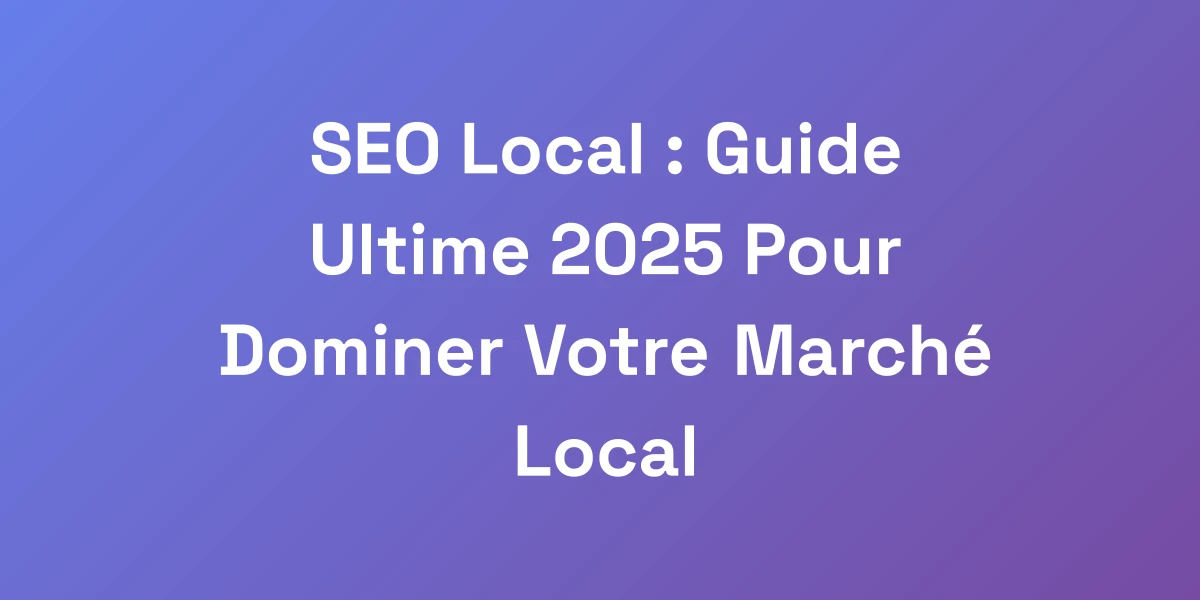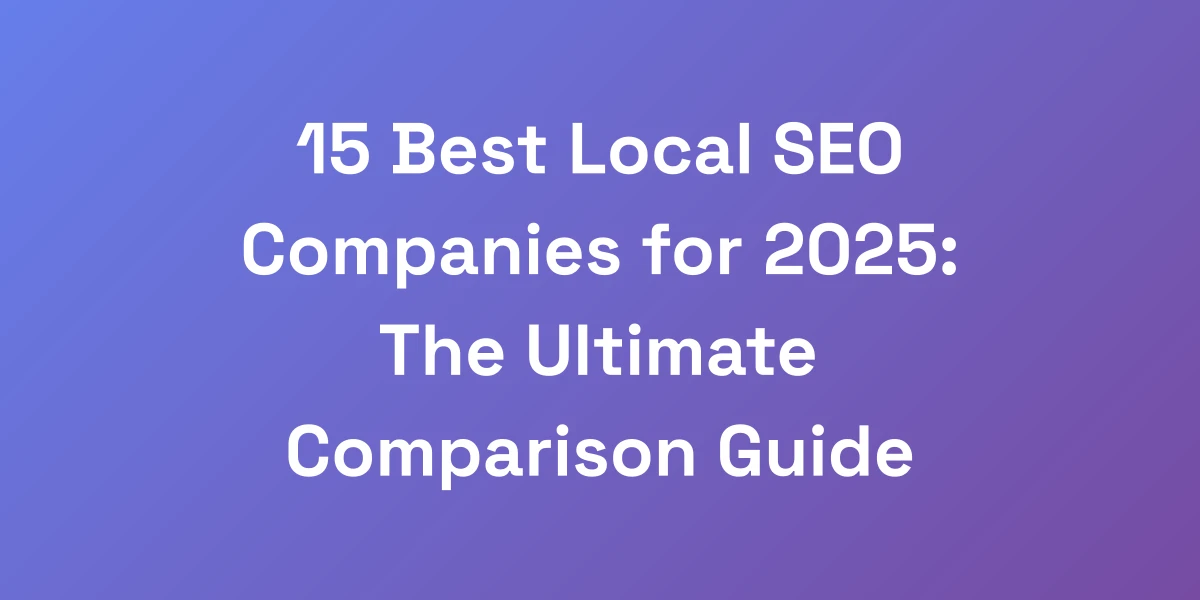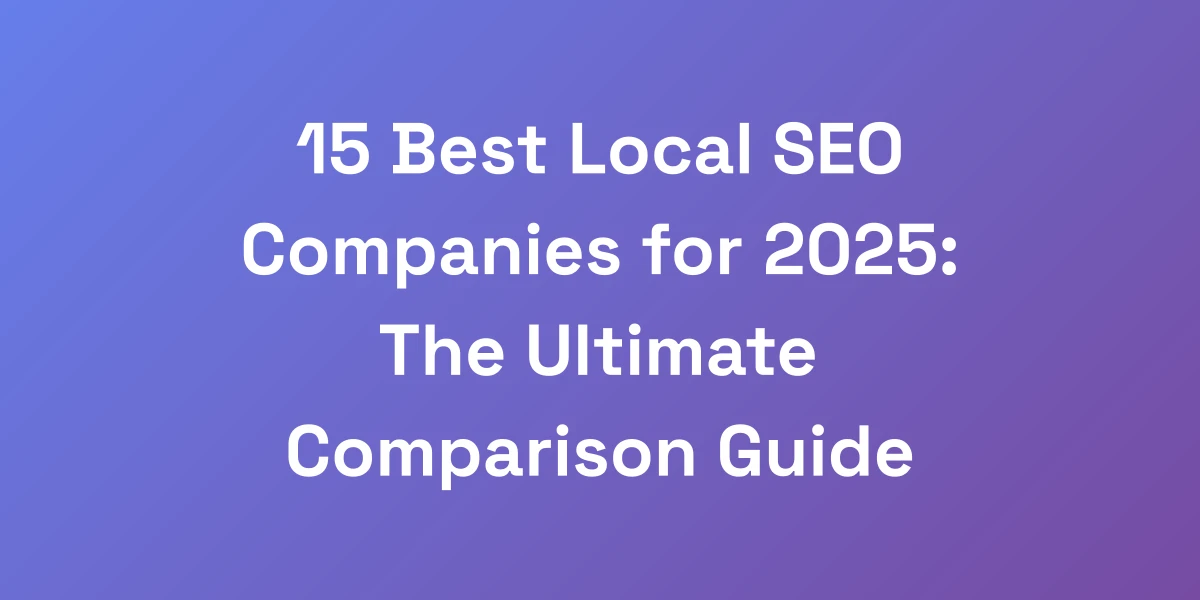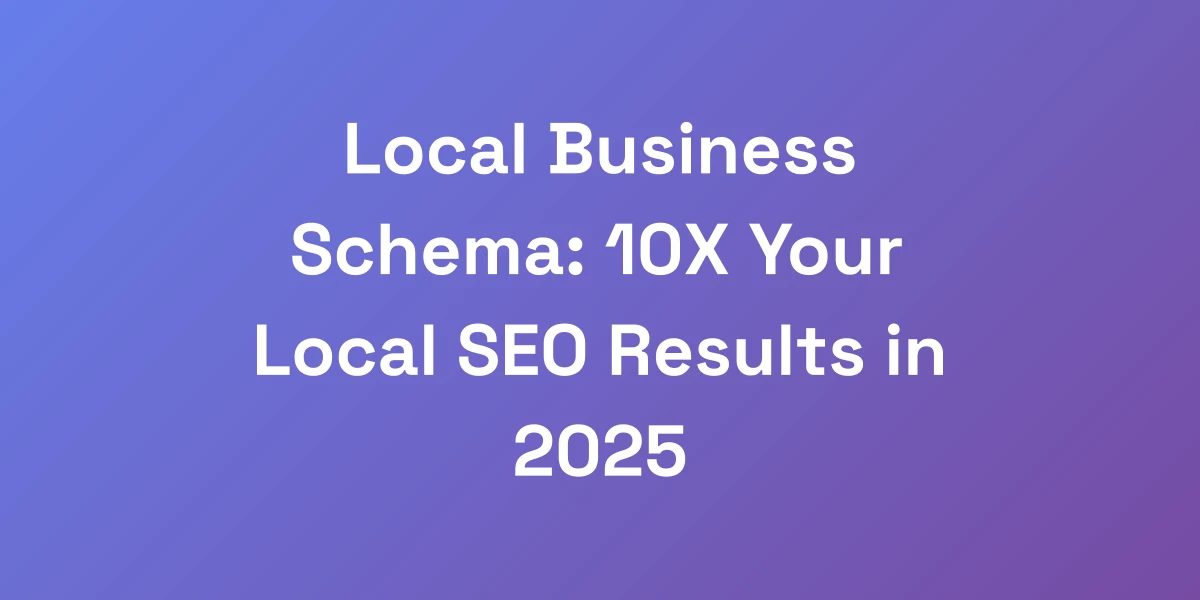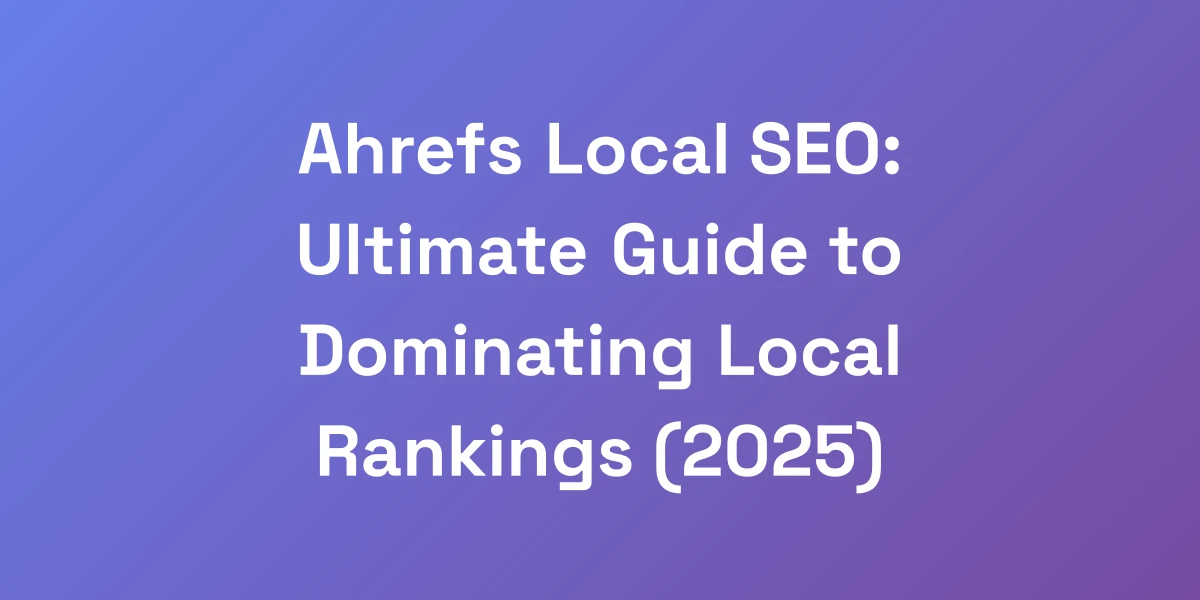
Ahrefs Local SEO: Ultimate Guide to Dominating Local Rankings (2025)
Mar 18, 2025 | By [email protected]
Listen up, we’re about to dive deep into something that can skyrocket your business growth overnight. Imagine dominating your local market so effortlessly that customers flock to you instead of your competitors. Ahrefs Local SEO is not just a tool; it’s your secret weapon for crushing local rankings in 2025. We’ve seen businesses transform from barely noticeable to the go-to name in their area, all by leveraging the power of local SEO with Ahrefs. But why is local SEO so critical, and how exactly does Ahrefs make the difference?
We’re not here to waste time with fluff. The reality is, if you’re not optimizing for local search, you’re missing out on serious revenue. Local SEO addresses the specific challenges of reaching customers in your vicinity, and Ahrefs equips you with the strategies and tools needed to dominate those local searches. Ready to leave your competition in the dust? Let’s get into the nitty-gritty of how you can use Ahrefs to become the undisputed local leader in your industry.
Why Local SEO Is Your Secret Weapon for Business Growth
Let us cut through the BS and tell you straight — if you’re not dominating local search, you’re leaving serious money on the table. Local SEO isn’t just another marketing buzzword — it’s the difference between being the go-to business in your area or watching competitors eat your lunch. We’ve helped countless businesses transform their local presence, and Ahrefs is the backbone of every success story. In this guide, we’re going to show you exactly how to use Ahrefs to crush your local competition and build an unstoppable local presence.
The Shocking Stats Behind Local Search Success
Did you know that 80% of US consumers search online for local businesses on a weekly basis, and 32% search for them daily? Imagine the flood of potential customers you’re overlooking if your business isn’t visible in these searches. These statistics highlight the critical need for a robust local SEO strategy. Moreover, 67% of 18-24 year olds use Instagram to search for local businesses, with another 62% using TikTok. This shift towards social media-driven local search behaviors demands a fresh approach to how we optimize our local presence.
And it doesn’t stop there. ‘Open now near me’ searches have increased by a staggering 400%, indicating a preference for immediate availability. This trend underscores the importance of real-time optimization and visibility. Finally, with 92% of searchers selecting businesses on the first page of local search results, the urgency to rank high locally has never been greater. These numbers aren’t just statistics; they’re wake-up calls for businesses ready to take their local SEO seriously.
Why Traditional SEO Falls Short for Local Businesses
Traditional SEO strategies focus on broad reach and global visibility, which can be a waste of resources if your customer base is predominantly local. Local businesses need a targeted approach that zeroes in on their immediate geographic area. Traditional SEO often overlooks the nuances of local search intent, such as location-specific keywords and local competition analysis. This gap is where local SEO shines, offering tailored strategies that address the unique needs of local markets.
Without local SEO, businesses miss out on high-intent customers who are actively seeking services or products within their vicinity. Traditional SEO might get you traffic, but it’s local SEO that converts that traffic into foot traffic and real sales. The landscape has shifted, and so should your SEO strategy. It’s not just about being seen; it’s about being seen by the right people in the right place at the right time.
The Ahrefs Advantage in Local Search
So, why Ahrefs? Simply put, Ahrefs offers a comprehensive suite of tools that are indispensable for mastering local SEO. From keyword research to competitor analysis, Ahrefs provides the insights you need to dominate local search results. Its Keywords Explorer allows you to uncover high-volume local keywords that your competitors are missing. The Site Explorer feature lets you analyze the backlink profiles of top local competitors, revealing opportunities for your own link-building strategies.
But the real game-changer is Ahrefs’ ability to integrate local data seamlessly into your SEO strategy. By leveraging features like Location-Specific Tracking and Custom Dashboards, we can monitor local rankings and adjust tactics in real-time. This isn’t just about having data; it’s about making that data work for you in a way that drives tangible results. Ahrefs doesn’t just support your local SEO efforts; it supercharges them.
Real Results: Case Studies of Local SEO Wins
Let’s talk results. Our clients have seen remarkable transformations using Ahrefs for local SEO. Take a local plumbing business in Brooklyn, for example. Before using Ahrefs, they were struggling to appear in local searches despite offering top-notch services. By implementing a targeted local keyword strategy identified through Ahrefs’ Keywords Explorer, they saw a 150% increase in local traffic within three months. Not only did their website traffic skyrocket, but their phone also started ringing off the hook with new customers.
Another success story is a boutique bakery in Austin. Using Ahrefs, they conducted a comprehensive competitor analysis to identify backlink opportunities. Through strategic partnerships with local food blogs and directories, they built a robust local backlink profile. The result? They jumped from the third page to the first page of local search results, doubling their sales and becoming the go-to spot for pastries in their neighborhood.
These case studies aren’t outliers; they’re proof that with the right tools and strategies, local SEO success is within reach. Ahrefs provides the foundation, but it’s the application of these insights that drives the real change. Ready to write your own success story? Let’s move forward.
Setting Up Your Local SEO Command Center in Ahrefs
Before you start throwing money at random tactics, you need to set up your local SEO infrastructure correctly. Most people mess this up from day one — but we’re going to show you the exact setup we use that generates consistent results. The key is leveraging Ahrefs’ powerful features specifically for local dominance. We’re talking about creating a systematic approach that turns your Ahrefs dashboard into a local SEO weapon. This isn’t theory — these are battle-tested strategies that work across any local market.
Essential Ahrefs Tools for Local SEO Success
First things first, let’s talk about the essential tools within Ahrefs that you’ll need to master for local SEO. These include:
- Keywords Explorer: Discover and analyze local keywords with high search volume and low competition.
- Site Explorer: Dive deep into your competitors’ backlink profiles and discover valuable local link opportunities.
- Content Explorer: Find the most popular local content and identify gaps that your business can fill.
- Rank Tracker: Monitor your local search rankings over time and adjust your strategy accordingly.
- Site Audit: Ensure your website is optimized for local SEO, identifying and fixing any technical issues.
These tools are the backbone of your local SEO strategy. By mastering them, you’re equipping yourself with the insights needed to dominate your local market.
Custom Dashboard Setup for Local Tracking
Next, setting up a custom dashboard in Ahrefs is crucial for tracking your local SEO performance. Here’s how we do it:
- Create a Local Dashboard: Start by customizing your dashboard to focus on local keywords, rankings, and backlink profiles.
- Add Widgets for Key Metrics: Include widgets that track your local search rankings, organic traffic, and backlink growth.
- Set Up Alerts: Configure alerts for significant changes in rankings or new backlinks from local sources.
- Regularly Review Data: Schedule weekly reviews to assess performance and make data-driven adjustments.
A well-organized dashboard ensures you’re always on top of your local SEO efforts, enabling quick responses to changes and opportunities.
Competitor Analysis Framework
Understanding your competition is vital for local SEO success. Here’s our framework using Ahrefs:
- Identify Local Competitors: Use Ahrefs’ Site Explorer to find businesses ranking for your target local keywords.
- Analyze Their Backlink Profiles: Look at the types of backlinks your competitors have and identify where you can acquire similar or better links.
- Examine Their Content Strategy: Use Content Explorer to see what local content is performing well for them and find gaps you can fill.
- Track Their Rankings: Monitor your competitors’ keyword rankings to spot trends and adjust your strategy accordingly.
This comprehensive competitor analysis ensures you’re ahead of the curve and capitalizing on every opportunity to outperform your rivals.
Local Keyword Research Blueprint
Local keyword research is a different beast altogether. Here’s our blueprint:
- Start with Seed Keywords: Identify basic keywords related to your business and location, such as “plumber in Brooklyn.”
- Use Ahrefs’ Keywords Explorer: Enter your seed keywords to discover related terms, search volumes, and keyword difficulty.
- Identify Long-Tail Keywords: Focus on long-tail keywords that have specific local intent, such as “emergency plumber near me.”
- Analyze Competitor Keywords: See what keywords your competitors are ranking for and find opportunities to target similar or underserved terms.
- Prioritize Based on Intent: Ensure the keywords you target align with the search intent of your local customers.
By following this blueprint, you’ll uncover high-value local keywords that can drive targeted traffic to your business.
Setting Up Location-Specific Tracking
To effectively track your performance across multiple locations, you need to set up location-specific tracking:
- Separate Dashboards for Each Location: Create individual dashboards in Ahrefs for each business location you operate.
- Customize Keyword Lists: Tailor your keyword lists to reflect the unique search behavior in each locale.
- Monitor Local Rankings: Use the Rank Tracker to keep an eye on your rankings for key local terms in each area.
- Adjust Strategies Accordingly: Based on performance data, fine-tune your local SEO strategies to better suit each location’s market dynamics.
This approach ensures that you’re not using a one-size-fits-all strategy but instead catering to the specific needs of each local market you serve.
Advanced Local Keyword Research Strategies Using Ahrefs
Listen up, because this is where most local businesses completely drop the ball. Keyword research for local SEO is a different animal, and we’re about to show you how to use Ahrefs to find the exact terms your ideal customers are searching for. We’re not just talking about adding “near me” to keywords — I’ll reveal our proprietary process for uncovering hidden local search opportunities that your competitors don’t even know exist. This is the same approach that’s helped our clients double their local traffic in under 90 days.
The “Neighborhood Method” for Finding Local Keywords
The “Neighborhood Method” involves breaking down your service area into specific neighborhoods or districts and targeting keywords unique to each. Here’s how we do it:
- Identify Key Neighborhoods: List out all the neighborhoods within your service area.
- Research Local Phrases: Use Ahrefs’ Keywords Explorer to find common phrases and terms used in each neighborhood.
- Optimize for Specific Terms: Create content targeting these localized terms to capture search intent specific to each area.
- Monitor Performance: Track how each neighborhood-specific keyword performs and adjust your strategy based on what’s working.
This method ensures you’re capturing traffic not just broadly but within specific, high-intent local segments.
Leveraging Ahrefs’ Keywords Explorer for Local Intent
Ahrefs’ Keywords Explorer is a goldmine for uncovering local intent keywords. Here’s how to leverage it effectively:
- Filter by Location: Use the location filter to narrow down keywords specific to your target area.
- Analyze Search Volume and Difficulty: Focus on keywords with a balance of high search volume and low to medium difficulty.
- Discover Related Keywords: Use the related keywords feature to find additional terms that can capture similar or complementary search intent.
- Evaluate Trends: Look at the trend data to identify seasonal or event-based local search opportunities.
By meticulously analyzing local intent keywords, you can create content that directly addresses the needs and searches of your local audience.
Competitive Gap Analysis for Local Terms
Competitive Gap Analysis involves identifying the keywords your competitors rank for that you currently don’t. Here’s our step-by-step process:
- Identify Your Top Competitors: Use Ahrefs to find the top-ranking local businesses for your primary keywords.
- Analyze Their Keyword Profile: Use the Site Explorer to see what keywords your competitors are ranking for.
- Identify Unmatched Keywords: Find keywords where your competitors are ranking but you’re not.
- Target These Gaps: Develop content and optimize pages to target these specific keywords, thereby filling the gaps in your own SEO strategy.
- Monitor Progress: Use the Rank Tracker to monitor your progress in ranking for these new keywords.
This approach ensures you’re not leaving any stone unturned in your local keyword strategy, allowing you to capitalize on every possible opportunity to rank higher.
Location-Specific Long-Tail Opportunities
Long-tail keywords are less competitive and more targeted, making them perfect for local SEO. Here’s how we find and use location-specific long-tail opportunities:
- Identify Detailed Search Queries: Look for long-tail phrases that include specific services and locations, such as “affordable electrician in downtown Chicago.”
- Create Specialized Content: Develop detailed content that addresses these specific queries, providing thorough answers and solutions.
- Optimize Meta Tags and Headings: Ensure your meta titles, descriptions, and headings include these long-tail keywords to enhance relevancy.
- Use Structured Data: Implement local business schema to help search engines understand the context of your content.
- Leverage User-Generated Content: Encourage reviews and testimonials that naturally include these long-tail phrases.
By focusing on these long-tail opportunities, you can attract highly targeted traffic that is more likely to convert into customers.
Seasonal and Event-Based Local Keywords
Seasonal and event-based keywords can drive significant traffic during specific times of the year. Here’s how to incorporate them into your strategy:
- Identify Key Seasons and Events: Determine the peak seasons and local events that are relevant to your business.
- Research Related Keywords: Use Ahrefs to find keywords related to these seasons and events, such as “Christmas tree delivery in Denver.”
- Create Timely Content: Develop content around these keywords ahead of time to capture early search interest.
- Optimize for Local Searches: Ensure that your content is optimized for the local audience looking for seasonal and event-related services.
- Promote Through Local Channels: Share your seasonal content through local social media groups, community boards, and local influencers to maximize visibility.
Leveraging seasonal and event-based keywords helps you stay relevant and top-of-mind during critical periods, driving spikes in local traffic and sales.
Building an Unbeatable Local Content Strategy
Here’s the truth about local content — it’s not about writing generic city pages. Your content strategy needs to be laser-focused on solving local problems. Using Ahrefs, we’ll create a content marketing for small businesses that actually moves the needle. We’re talking about content that ranks, converts, and establishes you as the local authority. This isn’t about pumping out blog posts — it’s about strategic content deployment that captures local search intent and drives real business results.
Content Gap Analysis for Local Markets
Content Gap Analysis helps identify the topics and keywords your competitors are covering that you’re missing. Here’s how to perform it:
- Identify Top Competitors: Use Ahrefs to find the top-ranking local businesses in your niche.
- Analyze Their Content: Use Content Explorer to see what content is driving traffic for them.
- Find Missing Topics: Identify topics and keywords that your competitors are covering but you are not.
- Develop New Content: Create detailed, high-quality content on these missing topics to fill the gaps.
- Optimize Existing Content: Update and enhance your current content to cover additional aspects and keywords, ensuring comprehensive coverage.
By addressing these gaps, you ensure your content strategy is thorough and covers all the bases needed to capture local search traffic.
Creating Location-Specific Content Clusters
Content clusters are groups of related content pieces centered around a single, comprehensive pillar page. Here’s how to create effective location-specific content clusters:
- Create Pillar Pages: Develop detailed pillar pages that cover broad topics relevant to your local audience, such as “Best Restaurants in Austin.”
- Develop Cluster Content: Write in-depth articles that explore specific subtopics related to the pillar, like “Top Vegan Restaurants in Austin” or “Family-Friendly Eateries in Austin.”
- Interlink Strategically: Link your cluster content back to the pillar page and vice versa to create a robust internal linking structure.
- Optimize for Local Keywords: Ensure each piece of content is optimized for specific local keywords identified during your keyword research.
- Update Regularly: Keep your content fresh and relevant by regularly updating it with new information and trends specific to your location.
This strategy not only boosts your SEO by creating a network of interconnected content but also positions you as the local authority on those topics.
Optimizing for Local Featured Snippets
Featured snippets are prime real estate in search results, and optimizing for them can significantly boost your visibility. Here’s how to target featured snippets:
- Identify Common Local Queries: Use Ahrefs’ Keywords Explorer to find questions and queries that locals frequently search for.
- Provide Clear, Concise Answers: Create content that directly answers these questions in a clear and concise manner, making it easy for Google to pull your content as a snippet.
- Use Structured Data: Implement local business schema to help search engines understand the context of your content.
- Format for Snippets: Use bullet points, numbered lists, and short paragraphs to increase the likelihood of your content being selected for a featured snippet.
- Optimize Titles and Headings: Make sure your titles and headings are optimized around the questions you’re targeting for snippets.
By optimizing for featured snippets, you can capture prominent positions in search results, driving more traffic and increasing your local authority.
Local News and Events Content Strategy
Engaging with local news and events can drive significant local traffic and enhance your community presence. Here’s how to integrate this into your content strategy:
- Cover Local Events: Write detailed posts about upcoming local events, workshops, and community gatherings relevant to your business.
- Share Local News: Provide insightful commentary or updates on local news that impacts your industry or community.
- Promote Through Local Channels: Share your content through local social media groups, community boards, and partnerships with local influencers.
- Encourage User Participation: Invite local customers to share their experiences and stories related to these events and news topics.
- Leverage Multimedia: Use images, videos, and infographics to make your local news and events content more engaging and shareable.
This approach not only drives local traffic but also strengthens your brand’s connection with the community, fostering loyalty and trust.
User-Generated Content Integration
User-generated content (UGC) is a powerful tool for enhancing your local SEO and building community trust. Here’s how to effectively integrate UGC:
- Encourage Reviews and Testimonials: Ask your customers to leave reviews on your website, Google Business Profile, and social media channels.
- Showcase Customer Stories: Feature detailed customer stories and experiences in your content to provide authentic insights.
- Implement Social Media Contests: Run contests encouraging users to share their experiences with your business, using a specific local hashtag.
- Create a Community Forum: Set up a local community forum where customers can share tips, ask questions, and discuss your products or services.
- Highlight User-Generated Content: Regularly feature UGC on your website and social media platforms to showcase real customer interactions and build trust.
Incorporating user-generated content not only enriches your website but also fosters a sense of community and authenticity, which are crucial for local SEO success.
Local Link Building Tactics That Actually Work
Forget everything you know about traditional link building. Local link building is a completely different game, and Ahrefs is your secret weapon for finding opportunities that actually matter. We’re going to show you how to build local authority through strategic partnerships and community connections. These aren’t just any links — these are relationship-based assets that strengthen your local presence and send trust signals to Google.
Finding Local Link Opportunities with Ahrefs
Ahrefs makes finding local link opportunities straightforward. Here’s how to do it:
- Use Site Explorer: Enter your competitors’ URLs to see where they are getting their local backlinks.
- Identify Local Directories: Look for local business directories and niche directories relevant to your industry.
- Explore Local Sponsorships: Find opportunities to sponsor local events, charities, or sports teams that provide backlink opportunities.
- Engage with Local Influencers: Use Ahrefs to find influencers in your area who can provide authoritative backlinks through mentions and collaborations.
- Leverage Ahrefs’ Content Explorer: Search for local content that’s performing well and identify backlink opportunities from those sources.
By systematically identifying and targeting these local links, you can build a strong backlink profile that enhances your local SEO efforts.
Community-Based Link Building Strategies
Building links through community engagement is highly effective. Here’s how to do it:
- Participate in Local Events: Sponsor or participate in local events and ensure your business is listed as a sponsor on their websites.
- Collaborate with Local Businesses: Form partnerships with non-competing local businesses and exchange backlinks through guest posts or joint promotions.
- Join Local Associations: Become a member of local business associations and chambers of commerce, which often provide backlinks to member websites.
- Host Workshops and Webinars: Offer free workshops or webinars on topics relevant to your community and get backlinks from event listings and local news coverage.
- Engage in Local Sponsorships: Support local charities or community projects and receive backlinks from their official websites.
These strategies not only help you acquire valuable backlinks but also strengthen your ties within the community, enhancing your local reputation and authority.
Local Business Directory Optimization
Optimizing your presence in local business directories is crucial for link building and local SEO. Here’s how:
- Claim Your Listings: Ensure your business is listed in all major local directories like Google Business Profile, Yelp, and Bing Places.
- Ensure NAP Consistency: Make sure your Name, Address, and Phone Number (NAP) are consistent across all directories.
- Choose Relevant Directories: Focus on directories that are relevant to your industry and locale to maximize SEO benefits.
- Optimize Your Profiles: Complete all sections of your directory profiles with accurate and detailed information, including descriptions, categories, and images.
- Encourage Reviews: Prompt satisfied customers to leave positive reviews on these directory listings to enhance your credibility and rankings.
By optimizing your local business directory listings, you not only gain valuable backlinks but also increase your visibility to potential local customers.
Competitive Link Analysis for Local Markets
Understanding where your competitors are getting their local backlinks can reveal opportunities for your own link-building efforts. Here’s how:
- Identify Top Competitors: Use Ahrefs’ Site Explorer to find local competitors who are ranking well for your target keywords.
- Analyze Their Backlink Profiles: Look at the types and sources of backlinks your competitors have acquired.
- Find Common Backlinks: Identify backlinks that multiple competitors share and evaluate if they’re relevant and attainable for your business.
- Discover Unique Opportunities: Find backlinks that only some competitors have and assess if you can also obtain them through similar strategies.
- Implement Similar Strategies: Use the insights gained to develop your own link-building tactics, targeting the same high-value backlinks your competitors have secured.
This competitive analysis ensures you’re not missing out on valuable link opportunities that could boost your local SEO performance.
Measuring Local Link Impact
Once you’ve built a solid local link profile, it’s essential to measure the impact of these links on your SEO performance. Here’s how:
- Track Backlink Growth: Use Ahrefs’ Site Explorer to monitor the number and quality of new backlinks acquired over time.
- Analyze Referral Traffic: Check how much traffic is coming from your new backlinks using Google Analytics and Ahrefs’ referral data.
- Monitor Keyword Rankings: Observe any changes in your local keyword rankings that correlate with your link-building efforts.
- Evaluate Domain Authority: Assess how your website’s domain authority evolves as you acquire more high-quality local backlinks.
- Adjust Strategies Accordingly: Based on your findings, refine your link-building strategies to focus on what’s driving the most positive impact.
Measuring the impact ensures your link-building efforts are effective and aligned with your overall local SEO goals, allowing you to continuously improve and scale your strategies.
Monitoring and Scaling Your Local SEO Success
Most businesses set it and forget it — that’s why they fail. Real local SEO success comes from constant monitoring and optimization. We’ll show you how to use Ahrefs to track your progress, identify new opportunities, and scale your success across multiple locations. This is about building a systematic approach to growing your local presence that can be replicated and scaled using the latest Ahrefs updates for 2024.
Setting Up Local Rank Tracking
Effective rank tracking is the foundation of monitoring your local SEO success. Here’s how to set it up:
- Define Your Target Keywords: List out all the local keywords you’re targeting for each location.
- Use Ahrefs’ Rank Tracker: Add these keywords to Ahrefs’ Rank Tracker and assign them to their respective locations.
- Set Update Frequencies: Choose how frequently you want to track your rankings, whether daily, weekly, or monthly.
- Monitor Changes: Regularly check the Rank Tracker to see how your rankings are improving or where adjustments are needed.
- Set Benchmarks: Establish baseline rankings for your keywords to measure progress over time.
By keeping a close eye on your rankings, you can quickly identify what’s working and what needs to be tweaked, ensuring continuous improvement in your local SEO efforts.
Performance Metrics That Matter
Focusing on the right metrics is crucial for measuring the effectiveness of your local SEO strategy. Here are the key metrics we track:
- Organic Traffic: Measure the amount of traffic coming from local search queries to gauge overall visibility.
- Keyword Rankings: Track how your target keywords are performing in local search results.
- Backlink Quality: Monitor the quality and relevance of your backlinks to ensure they contribute positively to your SEO.
- Conversion Rates: Assess how effectively your local traffic is converting into leads or sales.
- Engagement Metrics: Look at metrics like bounce rate, time on site, and pages per session to understand user engagement and satisfaction.
- Review Ratings: Monitor your online reviews and ratings, as they significantly impact local search visibility and credibility.
By focusing on these metrics, you can gain a comprehensive understanding of your local SEO performance and make informed decisions to enhance it.
Multi-Location Scaling Strategies
Scaling your local SEO across multiple locations requires a strategic approach. Here’s how to do it:
- Maintain Consistent NAP: Ensure that your Name, Address, and Phone Number are consistent across all locations and online platforms.
- Create Unique Content for Each Location: Develop location-specific content that caters to the unique needs and interests of each area.
- Use Location-Specific Keywords: Optimize your content with keywords that are relevant to each location’s search behavior.
- Implement Localized Link Building: Acquire backlinks from local sources in each area to build authority in multiple markets.
- Centralize Your Tracking: Use Ahrefs’ Custom Dashboards to monitor the performance of each location’s SEO efforts separately.
- Replicate Successful Strategies: Identify which strategies are working well in one location and implement them in others.
- Manage Reviews and Ratings: Encourage and manage online reviews for each location to build credibility and improve rankings across all areas.
Scaling effectively ensures that your local SEO efforts are amplifying your presence across all targeted locations, driving consistent growth and visibility.
Competitive Movement Monitoring
Keeping an eye on your competitors is essential for maintaining and improving your local SEO. Here’s how to monitor their movements:
- Track Competitor Rankings: Use Ahrefs’ Rank Tracker to monitor how your competitors’ keyword rankings change over time.
- Analyze Their Content Strategy: Regularly review the content your competitors are publishing to identify new trends and opportunities.
- Monitor Their Backlinks: Use Site Explorer to keep track of new backlinks your competitors are acquiring and assess their quality.
- Watch Their Reviews: Keep an eye on your competitors’ online reviews and ratings to understand their strengths and weaknesses.
- Identify New Strategies: Stay alert to any new SEO strategies or tactics your competitors are implementing and evaluate their effectiveness.
By continuously monitoring your competitors, you can stay ahead of the curve and adapt your strategies to maintain your local SEO dominance.
ROI Tracking and Reporting
Tracking the return on investment (ROI) of your local SEO efforts is crucial for understanding their impact. Here’s how to do it:
- Set Clear Goals: Define what success looks like for your local SEO efforts, whether it’s increased traffic, higher rankings, or more sales.
- Use Ahrefs to Track Performance: Monitor key metrics like organic traffic, keyword rankings, and backlink growth to assess performance.
- Calculate ROI: Compare the cost of your SEO efforts against the revenue generated from increased visibility and conversions.
- Generate Comprehensive Reports: Use Ahrefs’ reporting tools to create detailed reports that showcase your progress and ROI.
- Adjust Strategies Based on ROI: Use the insights from your ROI calculations to refine and optimize your local SEO strategies for better results.
By effectively tracking and reporting ROI, you ensure that your local SEO investments are delivering tangible business outcomes and can justify continued investment in these strategies.
